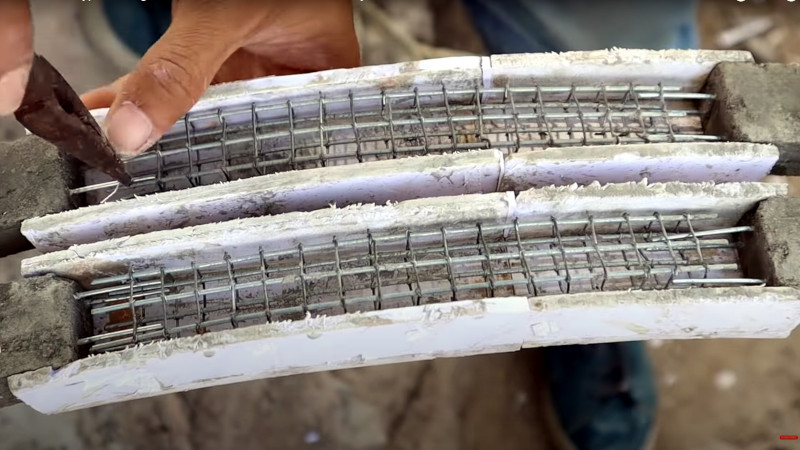In our community we’re no strangers to making things, and there are plenty among us who devote their efforts to modelmaking. It’s uncommon, though, for a scale model of something to be made using the exact same techniques as whatever it’s copying. Instead a model might be made from card, foam, glassfibre, or resin. [tiny WORLD] takes an opposite tack, building scale model civil engineering projects just as they would have been for real. (Video, embedded below.)
Here, a scale model of the Hoover Dam bypass bridge is made as the original, from reinforced concrete. In place of rebar is a wire grid in place of wooden shuttering is what looks like foam board, the concrete is a much smoother mortar, but otherwise it’s the real thing. We see the various bridge parts being cast in situ, with the result being as strong as you’d expect from the original.
We can see that this is a great technique for modelling concrete buildings and structures, but it’s also a material that we think might have other applications at this scale. How would the rigidity, strength, and mass of small-scale reinforced cement compare to 20-20 extrusion, 3D-printed plastic, or wood, for example? Regardless, it’s interesting to watch, as you can see from the video below the break.
Thanks [Michael Field] for the tip.

















Just get some passivated glass fibres and you will never think about the steel armature anzmore. It is so much better to cast Glas fiber reinforced concrete. The outcome is almost always superior both in aesthetics and mechanics as soon as you learn the details.
I think he wants to make it authentic the amount of attention to detail is amazing
Sure, good point. My comment was more a kind of advertisement for the technology I like than a criticism of the undoubtely epic achievement of TinyWorld.
He also could have 3d printed it and made the whole thing out of plastic but I think that misses the point of making a realistic scale model.
Amazing work!
I’m curious how (down) scaling a concrete construction affects other dimensions. Relative strength as the obvious question. But what about weather resistance? Lifetime? Cost?
I would expect that water ingress into concrete is a limiting factor here. Let’s say water penetrates to about 2cm from the surface and coroodes rebar, then the miniaturized version is bound to fail. Freezing water might also break things. But again, on this scale and dedication, an expoy coating or paint could be feasible?
On a semi-related topic, a few years ago I came across scaling of optical systems.
The overall volume / weight of a lens scales with third power of a linear size (diameter) so material cost goes with third power.
Efforts for polishing and surface coating/ finish goes with surface area (second power).
As a result it is plausible to have a cellphone lens with 3mm diameter and f1. 4 for ~1USD at a similar optical quality as a DSLR 1000USD lens.
Scaling the pixel size however affects low loght performance and noise
There are quite efficient hydrophobic agents for use with concrete.Moreover, contrary to intuition, you really want to have quite a lot of moisture in your concrete. It makes it stronger.
moist concrete is good only when curing, then the water becomes a pain in the rear…rusts structural steel, expands when frozen…
He he, a giant Indian!
:o)
Pretty big praying mantis too!
ugly building but nice bridge model ?
why doesn’t he fix the normal building first instead of playing with toy bridges
Nice, makes me think about the model village in Bourton-on-the-Water, Gloucester, England.
Its a model village of the local village, which they keep up to date, using the same materials as the real buildings. You add a dormer window into your roof, the model does likewise.
The model village is kept behind a local pub, I think, and in the model village’s pub, there is a model village – and inside that model of the model village there is a, yes, a model village.
The care used in construction though is amazing, bonsai-like trees and all.
https://en.wikipedia.org/wiki/Bourton-on-the-Water_model_village
Unleash the horrible goose!
There is a limit to how many models they can nest.
https://xkcd.com/878/
” How would the rigidity, strength, and mass of small-scale reinforced cement compare to 20-20 extrusion, 3D-printed plastic, or wood, for example? ”
Cement and concrete properties have been the subject of endless research, and the answer to the small-scale problem would likely be in the area of MDF – macro defect free cements which are similar to plastics in a lot of ways, and were developed by James Birchall at ICI in the 1970s. This has been less popular of late (likely in favor of 3-d printed houses or some such) but it’s intriguing stuff. No word on whether it’s available as 3D filament :-)
If you can pour concrete accurately enough at this small scale to do the mini rebar work you could perhaps have an x-y-z stage at a similar scale “3d print” with it. We’ve seen domes 3d printed from concrete for small buildings, what might small scale 3d printed conrete be useful for, even if it isn’t strong it could act as specially shaped ballast or counterweight parts within some mechatronic designs.
Also why is there no comments box on your previously posted article, plenty of people would surely like to add a note of the importance of civil liberties and of trusting your fellow human beings rather than fearing and surveilling them.
Unfortunately curing time does not scale down. 28 days…
It can when you buy a product like “cement all” it’s like 3000 psi in 1 hour, and 10000 psi in 28 days, it doesn’t have aggregate in it nor did the product that was used in the video
Lockdowns spawn another bizarre pre-stressed project.
Really impressive!
One of my favourite things in the video is how much the demolition work at 6:15 looks like the full-scale version. In terms of the material properties, that is, not in the work being done by a giant with wire cutters and a saw blade ;)